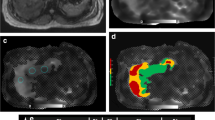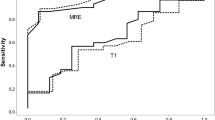Abstract
Objective:
To preliminarily evaluate the feasibility and usefulness of MR elastography of the liver at 3 T with cine-tagging and bending energy (BE) analysis for the evaluation of hepatic fibrosis.
Materials and Methods:
Twenty-two patients underwent MR elastography with four different cine-tagging grids on the liver (16- or 20-mm sagittal or coronal). Nine images serially obtained during 1-s of exhalation were analyzed to define coordinates of grid intersections. BE values were calculated using the thin-plate spline method. BE values were compared among patient groups with different fibrosis stage thresholds.
Results:
In the 22 patients, six had a fibrosis score of F0, one had F1, seven had F2, three had F3, and five had F4. Mean BE value with 16-mm sagittal grid was greater with fibrosis score F0 (1.54 ± 0.63) than with ≥F1 (0.97 ± 0.12, P = 0.013) as well as with ≤F1 (1.48 ± 0.60) than with ≥F2 (0.96 ± 0.36, P = 0.019).
Conclusion:
Our results showed that MR elastography with 16-mm sagittal grid and BE analysis had a potential in discrimination for the patients with moderate or advanced hepatic fibrosis from those with healthy liver or slight fibrosis.






Similar content being viewed by others
References
El-Serag HB, Mason AC (1999) Rising incidence of hepatocellular carcinoma in the United States. N Engl J Med 340:745–750
Yatsuhashi H, Yano M (2000) Natural history of chronic hepatitis C. J Gastroenterol Hepatol 15:111–116
Tokita H, Fukui H, Tanaka A et al (2005) Risk factors for the development of hepatocellular carcinoma among patients with chronic hepatitis C who achieved a sustained virological response to interferon therapy. J Gastroenterol Hepatol 20:752–758
Bravo AA, Sheth SG, Chopra S (2001) Liver biopsy. N Engl J Med 344:495–500
Regev A, Berho M, Jeffers LJ et al (2002) Sampling error and intraobserver variation in liver biopsy in patients with chronic HCV infection. Am J Gastroenterol 97:2614–2618
Snyder N, Gajula L, Xiao SY et al (2006) APRI: an easy and validated predictor of hepatic fibrosis in chronic hepatitis C. J Clin Gastroenterol 40:535–542
Wai CT, Greenson JK, Fontana RJ et al (2003) A simple noninvasive index can predict both significant fibrosis and cirrhosis in patients with chronic hepatitis C. Hepatology 38:518–526
Koda M, Matunaga Y, Kawakami M et al (2007) FibroIndex, a practical index for predicting significant fibrosis in patients with chronic hepatitis C. Hepatology 46:280–281
Muthupillai R, Lomas DJ, Rossman PJ et al (1995) Magnetic resonance elastography by direct visualization of propagating acoustic strain waves. Science 269:1854–1857
Rouvière O, Yin M, Dresner MA et al (2006) MR elastography of the liver: preliminary results. Radiology 240:440–448
Huwart L, Sempoux C, Salameh N et al (2007) Liver fibrosis: noninvasive assessment with MR elastography versus aspartate aminotransferase-to-platelet ratio index. Radiology 245:458–466
Lucidarme O, Baleston F, Cadi M et al (2003) Non-invasive detection of liver fibrosis: is superparamagnetic iron oxide particle-enhanced MR imaging a contributive technique? Eur Radiol 13:467–474
Aguirre DA, Behling CA, Alpert E et al (2006) Liver fibrosis: noninvasive diagnosis with double contrast material-enhanced MR imaging. Radiology 239:425–437
Taouli B, Tolia AJ, Losada M et al (2007) Diffusion-weighted MRI for quantification of liver fibrosis: preliminary experience. AJR Am J Roentgenol 189:799–806
Friedrich-Rust M, Ong MF, Herrmann E et al (2007) Real-time elastography for noninvasive assessment of liver fibrosis in chronic viral hepatitis. AJR Am J Roentgenol 188:758–764
Kato H, Kanematsu M, Zhang X et al (2007) Computer-aided diagnosis of hepatic fibrosis: preliminary evaluation of MRI texture analysis using the finite difference method and an artificial neural network. AJR Am J Roentgenol 189:117–122
Zerhouni EA, Parish DM, Rogers WJ et al (1988) Human heart: tagging with MR imaging—a method for noninvasive assessment of myocardial motion. Radiology 169:59–63
Axel L, Dougherty L (1989) MR imaging of motion with spatial modulation of magnetization. Radiology 17:841–845
Axel L, Dougherty L (1989) Heart wall motion: improved method of spatial modulation of magnetization for MR imaging. Radiology 172:349–350
Bolster BD Jr, McVeigh ER, Zerhouni EA (1990) Myocardial tagging in polar coordinates with use of striped tags. Radiology 177:769–772
Castillo E, Lima JA, Bluemke DA (2003) Regional myocardial function: advances in MR imaging and analysis. Radiographics 23:127–140
Finn JP, Nael K, Deshpande V et al (2006) Cardiac MR imaging: state of the technology. Radiology 241:338–354
de Bazelaire CM, Duhamel GD, Rofsky NM et al (2004) MR imaging relaxation times of abdominal and pelvic tissues measured in vivo at 3.0 T: preliminary results. Radiology 230:652–659
Bookstein FL (1989) Principal warps: thin-plate splines and the decomposition of deformations. IEEE Trans Pattern Anal Mach Intell 6:567–585
Acknowledgements
This work was supported by Japan Society for the Promotion of Science KAKENHI (20591439) and in part by the Health and Labour Sciences Research Grants for Third Term Comprehensive Control Research for Cancer.
Author information
Authors and Affiliations
Corresponding author
Appendix
Appendix
The BE is invariant for movements of the liver such as rotation and translation and is only related to the energy that is used to deform the liver parenchyma. This property makes it very suitable to provide a quantitative measure of softness of the liver in cine-tagging MR images. The number of the points that were used to show the liver is an important parameter during the BE computations. This theory is used in non-rigid warping method known as thin plate spline [24].
Rights and permissions
About this article
Cite this article
Watanabe, H., Kanematsu, M., Kitagawa, T. et al. MR elastography of the liver at 3 T with cine-tagging and bending energy analysis: preliminary results. Eur Radiol 20, 2381–2389 (2010). https://doi.org/10.1007/s00330-010-1800-0
Received:
Revised:
Accepted:
Published:
Issue Date:
DOI: https://doi.org/10.1007/s00330-010-1800-0




